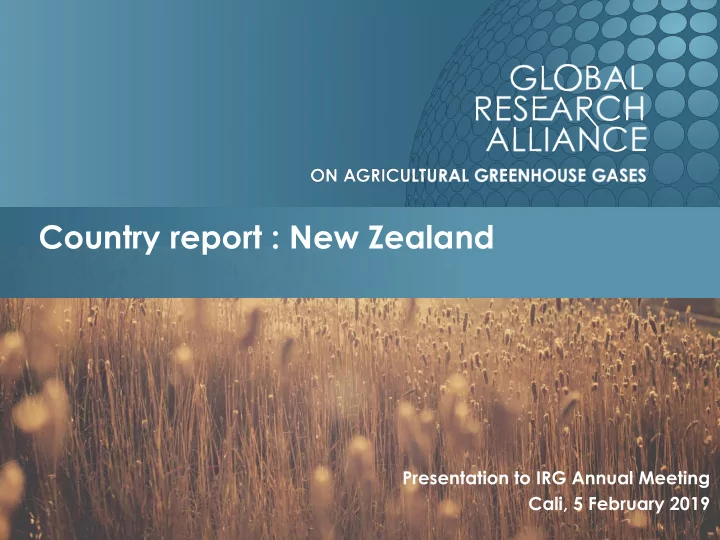

Country report : New Zealand Presentation to IRG Annual Meeting Cali, 5 February 2019
Current NZ research to support inventory improvement • Understanding cattle CH 4 yields at 500 very low and very high levels of 400 feed intake (< 6kg and > 14kg), improving accuracy of estimates on 300 CH4 [g/d] Pasture only young animals and high producing Suppl. Low level animals respectively. 200 Suppl. Med. level Suppl. High level • Review and improvement of the Young 4 month 100 animal weight gain calculation Artificial model, to improve transparency Natural 0 and robustness of liveweight 0 5 10 15 20 25 estimates. DMI [kg/d] • Meta-analysis for emission factors from N 2 O emissions from livestock on hill country for variable gradient slopes.
Current NZ research to support inventory improvement • Successful inclusion to inventory: Review of N partitioning relationship for ruminants has resulted in updated methodology and represents improved accuracy in the national inventory. • Improving estimates of supplemental feed use for Dairy, Beef and Sheep industries. • Gathering further pasture quality samples to input into framework developed last year of existing national pasture quality data. • Improving understanding of the causes of variability and the processes driving N 2 O emissions from livestock excreta on pasture.
Overarching frame work - soil C How much soil carbon nationally and where? What land uses and Potential soil practices alter carbon carbon storage stocks – up or down? Do carbon beneficial management practices result in emissions of other GHGs? Increase soil carbon or avoid losses nationally Extrapolation through modelling and spatial sampling 21 February 2019 |
Current C stocks and sequestration potential 60 National C sequestration potential 50 Total storage = 124 Mt (0-0.15 m) 40 (millions t) Ag emissions = 11 Mt/y (2014) 30 20 10 0 Brown Gley Pumice Recent Semiarid Allophanic Melanic Pallic Ultic Manaaki Whenua Landcare Research McNally et al. (2017) GLOBAL CHANGE BIOLOGY: 23: 4544-4555 Future tracking national soil carbon stock change Sampling strategy and measurement 5 Soil carbon Programme – NZAGRC Review 2018
Sampling design for soil carbon research • Data for inventory/research has generally come from historical surveys: • Biased towards areas of intensive agricultural activity • Subjective sampling design, rather than random • Less representative of whole of New Zealand environment • Low- or under-powered studies in some cases • End users are now asking more complex questions: • How are soil properties changing over space & time? • Can we be sure the conclusions using this data are reliable? • What is the chain of evidence for this analysis? • Increased use of spatial sampling power analysis: • Generally, simulation methods must be used • More effort required to document and quantify justifiable assumptions • Challenge is to communicate results to end users in clear non-technical language 21 February 2019 | 6
Recent examples of sampling design • Is hill-country grassland soil carbon increasing over time? • Power analysis based on a published pilot study • Balanced spatial sampling for representativeness • Sampling set selection based on minimum visit distance • Design framework for lowland grassland soil carbon monitoring • Power analysis using simulation, based on: Published historical data Expert knowledge concerning justifiable assumptions • Have already shown that sample effort strongly dependent on chosen assumptions 7 Ongoing… farm scale assessment approach
Mitigation practices: Looking for gains and avoiding losses Supported by mechanistic process studies Gains/gained Losses/lost Maintain Irrigation Diverse Tested or swards under testing Pasture Biochar renewal Inversion process tillage Maize Phosphorus Conversion Conversion from from forest to pasture to forest Conversion to pasture dairy? Known Nitrogen fertiliser, fodder cropping, plantain, cut and carry, tussock unknowns management, grazing regimes … Synthetic reviews: The current position: Schipper et al. (2017) NZ J Ag. Res. 60(2): 93 – 118. The opportunities: Whitehead et al (2018) Ag. Ecosystems Environ. 265:432-443.
Note: not a full carbon balance 21 February 2019 | 9
Connecting measurement, modelling, and production trade-offs Needs LCA including nitrous oxide and methane Supported by process studies Feedback loop to experimentalists Kirschbaum et al (2017). Science of the Total Environment 577: 61-72. 5 Soil carbon Programme – NZAGRC Review 2018
Specific contributions to other Groups related to IRG activities Developed agricultural MRV platform www.agmrv.org with CCAFS • Produced collection of Tier 2 • Inventory approaches in the livestock sector
Comparing trade-offs soil carbon and nitrous oxide We need to ensure that any mitigation practice successful for one gas does not cause does not emissions of another. Liang et al 2018 Agriculture Ecosystems and Environment. 268:171-180. 5 XXX Programme – NZAGRC Review 2018
Recommend
More recommend